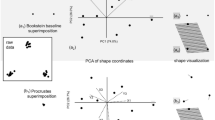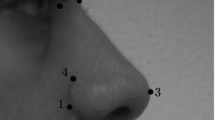Abstract
The study of shape changes in morphology has seen a significant renovation in the last 20 years, particularly as a consequence of the development of geometric morphometric methods based on Cartesian coordinates of points. In order to extract information about shape differences when Cartesian coordinates are used, it is necessary to establish a common reference frame or system for all specimens to be compared. Therefore, a central issue in coordinate-based methods is which criterion should be used to align these configurations of points, since shape differences highly depend on those alignments. This is usually accomplished by aligning the configurations in a way that the sum of squared distances between coordinates of homologous points (landmarks) is minimized: the least-squares superimposition method. However, it is widely recognized that this method has some limitations when shape differences are not homogeneous across landmarks. Here we present an integrated approach for the resistant shape comparison of 3D landmark sets. It includes a new ordinary resistant Procrustes superimposition and its corresponding generalized resistant Procrustes version. In addition, they are combined with existing resistant multivariate statistical techniques for depicting the results. We demonstrate, by using both simulated and real datasets, that resistant Procrustes better detects and measures localized shape variation whenever present in up to half but one of the landmarks. The resistant Procrustes results are highly concordant with a priori biological information, and might dramatically improve the quality of inferences on patterns of shape variation.












Similar content being viewed by others
References
Adams, D. C., Rohlf, F. J., & Slice, D. E. (2004). Geometric morphometrics: 10 years of progress following the ‘revolution’. Italian Journal of Zoology, 71, 5–16.
Adams, D. C., Rohlf, F. J., & Slice, D. E. (2013). A field comes of age: Geometric morphometries in the twenty first century. Hystrix, 24(1), 7–14.
Agarwal, A., Phillips, J. M., & Venkatasubramanian, S. (2010). Universal multidimensional scaling. In KDD’10: Proceedings of the 16th ACM SIGKDD international conference on knowledge discovery and data mining (pp. 1149–1158). New York: ACM.
Bookstein, F. L. (1991). Morphometric tools for landmark data: Geometry and biology. New York: Cambridge University Press.
Bookstein, F. L. (1996). Biometrics, biomathematics and the morphometric synthesis. Bulletin of Mathematical Biology, 58(2), 313–365.
Catalano, S. A., & Goloboff, P. A. (2012). Simultaneously mapping and superimposing landmark configurations with parsimony as optimality criterion. Systematical Biology, 61(3), 392–400.
Cayton, L., & Dasgupta, S. (2006). Robust Euclidean embedding. In ICML’06: Proceedings of the 23rd international conference on machine learning (pp. 169–176). New York, ACM.
Cheverud, J. (1995). Morphological integration in the saddleback tamarin (Saguinus fuscicollis) cranium. American Naturalist, 145(1), 63–89.
Davis, J. C. (1986). Statistics and data analysis in geology. New York: Wiley.
Donoho, D. L., & Huber, P. J. (1983). The notion of breakdown point. In P. J. Bickel et al. (Eds.), A Festschrift for Erich L. Lehmann (pp. 157–184). Belmont, Wadsworth.
Gantmacher, F. R. (1959). The theory of matrices, Vols. 1 and 2. New York, Chelsea.
Gower, J. C. (1970). Statistical methods of comparing different multivariate analyses of the same data. In F.R. Hodson et al. (Eds.), Mathematics in the archaelogical and historical sciences (pp. 138–149). Edinburgh, Edinburgh University Press.
Gower, J. C. (1975). Generalized procrustes analysis. Psychometrika, 40(1), 33–51.
Hallgrimsson, B., & Lieberman, D. E. (2008). Mouse models and the evolutionary developmental biology of the skull. Integrative and Comparative Biology, 48(3), 373–384. doi:10.1093/icb/icn076.
Hammer, Ø., Harper, D. A. T., & Ryan, P. D. (2001). PAST: Paleontological statistics software package for education and data analysis. Palaeontologia Electronica 4(1), art. 4, 9.
Hampel, F. R., Ronchetti, E. M., Rouseeuw, P. J., & Stahel, W. A. (1986). Robust statistics: The approach based on influence functions. New York: Wiley.
Hartwig, W., Rosenberger, A. L., Norconk, M. A., & Owl, M. Y. (2011). Relative brain size, gut size, and evolution in New World monkeys. Anatomical Record (Hoboken), 294(12), 2207–2221.
Kendall, D. G. (1984). Shape manifolds, procrustean metrics, and complex projective spaces. Bulletin London Mathematical Society,. doi:10.1112/blms/16.2.81.
Klingenberg, C. P. (2013). Visualizations in geometric morphometrics: How to read and how to make graphs showing shape changes. Hystrix, 24(1), 15–24.
Lemey, M., Salemi, M., & Vandamme, A. M. (2009). The phylogenetic handbook: A practical approach to phylogenetic analysis and hypothesis testing. Cambridge: Cambridge University Press.
Mitteroecker, P., & Gunz, P. (2009). Advances in geometric morphometrics. Evolutionary Biology, 36, 235–247.
Mitteroecker, P., Gunz, P., & Bookstein, F. L. (2005). Heterochrony and geometric morphometrics: a comparison of cranial growth in Pan paniscus versus Pan troglodytes. Evolution and Development, 7(3), 244–258.
Perez, S. I., Bernal, V., & Gonzalez, P. N. (2006). Differences between sliding semi-landmark methods in geometric morphometrics, with an application to human craniofacial and dental variation. Journal of Anatomy, 208(6), 769–784.
Perez, S. I., Klaczko, J., Rocatti, G., & dos Reis, S. F. (2011). Patterns of cranial shape diversification during the phylogenetic branching process of New World monkeys (Primates: Platyrrhini). Journal of Evolutionary Biology, 24(8), 1826–1835.
Richtsmeier, J. T., DeLeon, V. B., & Lele, S. R. (2002). The promise of geometric morphometrics. American Journal of Physical Anthropoloy, Supplement 35, 63–91.
Rocha, M. A. (1995). Les collections ostéologiques humaines identifiées du Musée Anthropologique de l′Université de Coimbra. Antropologia Portuguesa, 13, 7–38.
Rohlf, F. J. (1990). Rotational fit (Procrustes) methods. In F.J. Rohlf et al., (Eds.) Proceedings Michigan morphometrics workshop (pp. 227–236). Special publication no. 2, Museum of Zoology. Michigan, University of Michigan.
Rohlf, F. J., & Marcus, L. F. (1993). A revolution in morphometrics. Tree, 8, 129–132.
Rohlf, F. J., & Slice, D. E. (1990). Extensions of the Procrustes method for the optimal superimposition of landmarks. Systematic Zoology, 39(1), 40–59.
Siegel, A. F. (1982). Robust regression using repeated medians. Biometrika, 69(1), 242–244.
Siegel, A. F., & Benson, R. H. (1982). A robust comparison of biological shapes. Biometrics, 38, 341–350.
Slice, D. E. (1996). Three-dimensional generalized resistant fitting and the comparison of least-squares and resistant fit residuals. In L. F. Marcus et al., (Eds.), Advances in morphometrics (pp. 179–199). New York, Plenum Press.
Slice, D. E. (2001). Landmark coordinates aligned by Procrustes analysis do not lie in Kendall’s shape space. Systematic Biology, 50(1), 141–149.
Sperber, G. H. (2001). Craniofacial development. Hamilton: BC Decker Inc.
Taguchi, Y. H., & Oono, Y. (2004). Novel non-metric MDS algorithm with confidence level test. http://www.granular.com/MDS/src/paper.pdf.
Theobald, D. L., & Wuttke, D. S. (2006). Empirical Bayes hierarchical models for regularizing maximum likelihood estimation in the matrix Gaussian Procrustes problem. Proceedings of the National Academy of Sciences of the United States of America, 103, 18521–18527.
Van der Linde, K., & Houle, D. (2009). Inferring the nature of allometry from geometric data. Evolutionary Biology, 36, 311–322.
Walker, J. A. (2000). Ability of geometric morphometric methods to estimate a known covariance matrix. Systematic Biology, 49(4), 686–696.
Weiszfeld, E. (1937). Sur le point pour lequel la somme des distances de n points donnés est minimum. Tohoku Mathematical Journal, 43, 355–386.
Zelditch, M. L., Swiderski, D. L., Sheets, H. D., & Fink, W. L. (2004). Geometric morphometric for biologists: A primer. London: Academic Press.
Acknowledgments
We want to thank Fundación Antorchas for partially funding Mr. Torcida for this research. We are grateful to Dennis Slice, Dean Adams and Sergio F. dos Reis for their helpful comments on early versions of this manuscript.
Author information
Authors and Affiliations
Corresponding author
Appendix: Optimality of the Presented Resistant Method (Overall Performance When Shape Variation is Located in Half but One of the Landmarks)
Appendix: Optimality of the Presented Resistant Method (Overall Performance When Shape Variation is Located in Half but One of the Landmarks)
The 3D version of the resistant method presented in this work achieves the best possible superimposition whenever shape differences are located in up to 50 % of the landmarks. This is proved next.
Theorem
Suppose there exist parameters ρ > 0 (an isotropic scaling), R (v , θ) (a 3D rotation matrix with associated rotation angle θ and rotation axis v , respectively) and t (a translation vector) such that the equation:
holds for more than \( \frac{{{n} + 1}}{2} \) different landmarks, the repeated-medians estimates (6), (7), (9) and the single median (11) are exactly those values; that is,
and
Proof
The result is showed only for the rotation matrix parameters, because they use the specific formulation for the 3D case. The proof for the remaining parameters is analogous.
Whenever more than \( \frac{{{n} + 1}}{2} \) in a set of values are the same, the median is that repeated value. Then, when landmarks l (k) i and l (k) j satisfy (14):
and setting for the moment ρ = 1 (the scale factor can be estimated afterwards, without loss of generality) the rotation matrix R ij satisfies equations (1), (2), (3) and consequently (4), producing:
From this, whenever landmark l (k) i satisfies (14), more than half of the remaining landmarks l (k) j (j ≠ i) also satisfy (14) and therefore:
which leads to:
and finally:
which concludes the proof.
Rights and permissions
About this article
Cite this article
Torcida, S., Ivan Perez, S. & Gonzalez, P.N. An Integrated Approach for Landmark-Based Resistant Shape Analysis in 3D. Evol Biol 41, 351–366 (2014). https://doi.org/10.1007/s11692-013-9264-1
Received:
Accepted:
Published:
Issue Date:
DOI: https://doi.org/10.1007/s11692-013-9264-1




